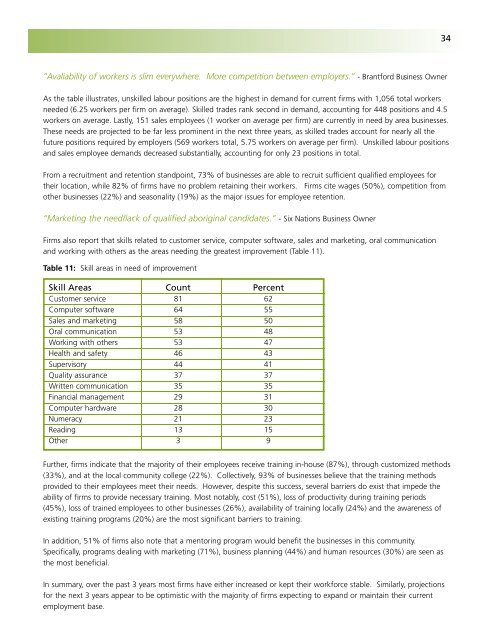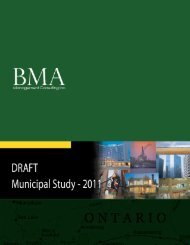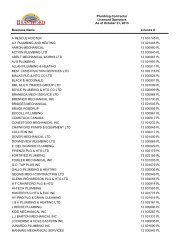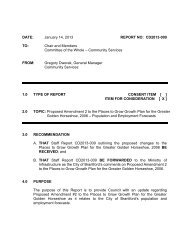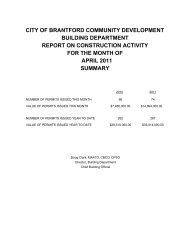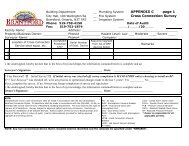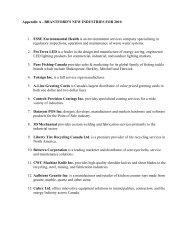Business Retention and Expansion Final Report - City of Brantford
Business Retention and Expansion Final Report - City of Brantford
Business Retention and Expansion Final Report - City of Brantford
Create successful ePaper yourself
Turn your PDF publications into a flip-book with our unique Google optimized e-Paper software.
34“ Avaliability <strong>of</strong> workers is slim everywhere. More competition between employers.” - <strong>Brantford</strong> <strong>Business</strong> OwnerAs the table illustrates, unskilled labour positions are the highest in dem<strong>and</strong> for current firms with 1,056 total workersneeded (6.25 workers per firm on average). Skilled trades rank second in dem<strong>and</strong>, accounting for 448 positions <strong>and</strong> 4.5workers on average. Lastly, 151 sales employees (1 worker on average per firm) are currently in need by area businesses.These needs are projected to be far less prominent in the next three years, as skilled trades account for nearly all thefuture positions required by employers (569 workers total, 5.75 workers on average per firm). Unskilled labour positions<strong>and</strong> sales employee dem<strong>and</strong>s decreased substantially, accounting for only 23 positions in total.From a recruitment <strong>and</strong> retention st<strong>and</strong>point, 73% <strong>of</strong> businesses are able to recruit sufficient qualified employees fortheir location, while 82% <strong>of</strong> firms have no problem retaining their workers. Firms cite wages (50%), competition fromother businesses (22%) <strong>and</strong> seasonality (19%) as the major issues for employee retention.“Marketing the need/lack <strong>of</strong> qualified aboriginal c<strong>and</strong>idates.” - Six Nations <strong>Business</strong> OwnerFirms also report that skills related to customer service, computer s<strong>of</strong>tware, sales <strong>and</strong> marketing, oral communication<strong>and</strong> working with others as the areas needing the greatest improvement (Table 11).Table 11: Skill areas in need <strong>of</strong> improvementSkill Areas Count PercentCustomer service 81 62Computer s<strong>of</strong>tware 64 55Sales <strong>and</strong> marketing 58 50Oral communication 53 48Working with others 53 47Health <strong>and</strong> safety 46 43Supervisory 44 41Quality assurance 37 37Written communication 35 35Financial management 29 31Computer hardware 28 30Numeracy 21 23Reading 13 15Other 3 9Further, firms indicate that the majority <strong>of</strong> their employees receive training in-house (87%), through customized methods(33%), <strong>and</strong> at the local community college (22%). Collectively, 93% <strong>of</strong> businesses believe that the training methodsprovided to their employees meet their needs. However, despite this success, several barriers do exist that impede theability <strong>of</strong> firms to provide necessary training. Most notably, cost (51%), loss <strong>of</strong> productivity during training periods(45%), loss <strong>of</strong> trained employees to other businesses (26%), availability <strong>of</strong> training locally (24%) <strong>and</strong> the awareness <strong>of</strong>existing training programs (20%) are the most significant barriers to training.In addition, 51% <strong>of</strong> firms also note that a mentoring program would benefit the businesses in this community.Specifically, programs dealing with marketing (71%), business planning (44%) <strong>and</strong> human resources (30%) are seen asthe most beneficial.In summary, over the past 3 years most firms have either increased or kept their workforce stable. Similarly, projectionsfor the next 3 years appear to be optimistic with the majority <strong>of</strong> firms expecting to exp<strong>and</strong> or maintain their currentemployment base.


